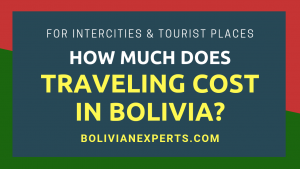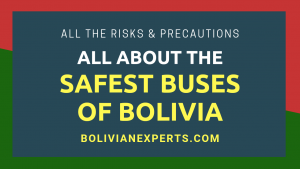In Bolivia, by far the most used currency is the local one called the Boliviano, for almost any common transaction, but it doesn’t mean that the Dollar is not used at all, in fact, it’s preferred for important deals that involve a lot of money and also it’s widely used in tourist areas.
The best currency for Bolivia is generally the Boliviano (Bs) in cash, as it is preferred for making small and normal day-to-day transactions, but for larger and more critical transactions over $1,000, the preferred currency is the Dollar. Euros and other currencies are almost not used in any situation.
Here, we’ll be talking about which one is the best currency to use in Bolivia, for different situations, and several types of people, like tourists or common Bolivians. You’ll also know how much of each currency you’ll daily need when staying or visiting our country.
What’s the best currency for Bolivia?
For Bolivia, the best currency depends on the type of transaction you are going to make and also the type of person you are:
- If you are a common tourist, Bs300 per day, with $200 as a backend, both in cash, along with a few hundred dollars in a credit or debit card will be your best mix.
- If you want to live like a normal Bolivian (be careful, you need to know what you are doing), Bs150 per day (~$22) and maybe a debit card with some money in Bolivianos, will be your best mix.
- If you want to buy important or expensive goods and services like Airbnbs, multiple-star hotels, flying tickets, tourist packages, expensive electronics, rent or buy cars or buy real estate in Bolivia, then the Dollar $ (not cash for large quantities, as it’s very dangerous) is the best currency for making these transactions.
- If you want to buy common stuff like food, groceries, clothing, souvenirs, books, go to the cinema, parks, ground transportation, etcétera, the Boliviano (Bs) is the best currency in this case.
| Common Tourist | Common Bolivian | To buy normal stuff (<$1,000) | To buy critical stuff (>$1,000) | |
| Best currency | Bolivianos | Bolivianos | Bolivianos | Dollars |
| How much? | ||||
| Bolivianos (cash) | Bs300 | Bs70-Bs150 | necessary | accepted |
| Dollars (cash) | $200 (for contingencies) | $0 | not necessary | best accepted (not cash! is risky) |
| Credit card | $500-$1,000 | $100-$200 | Sometimes accepted | Sometimes accepted |
| Euros | Almost useless | Almost useless | Almost useless | Almost useless |
| Other currencies | Useless | Useless | Useless | Useless |
Now let’s see why these numbers and guidelines make sense when you are staying or visiting our country.
In Bolivia, 2 currencies have widespread use
1) The country’s currency Boliviano (Bs, BOB)
The local currency, the Boliviano, is by far the most widely used to make almost all minor transactions in Bolivia. This currency is used when people pay for small goods and services, also ground transportation, food, apparel, and similar common stuff.
Nevertheless, when making more critical or larger transactions (in general the ones that are over >$1,000) people prefer to use USD Dollars, then for example, if you buy a PC in our country, many of the sellers will gratefully accept dollars as payment.
Don’t use cash when you pay more than $1,000, better to use a bank account or a credit or debit card in Bolivia, as you are at risk of becoming the target of thefts.
In regards to tourist services and stuff, most tourist agencies will equally accept both Bolivianos and Dollars with no trouble as payment or to make transactions.
2) The US dollar currency ($, USD)
As we just mentioned, dollars are very welcomed in Bolivia for more important or larger transactions, such as paying for flying tickets, premium hotels, and many tourist packages, or when buying phones, PCs, cars, houses, etcétera.
But for minor transactions, for example, buying groceries in open markets, or paying for a taxi, dollars in cash may become trouble and many sellers won’t accept this currency.
The Euro is almost not used in Bolivia
Euros are almost not used in Bolivia, neither in common, small nor more critical or larger transactions. Even in ATMs, this currency is almost absent, and for every 100 ATMs maybe 1 or 2 will have the option to deposit or withdraw in Euros.
Banks are also very hesitant to use Euros and they prefer Dollars as the main foreign currency for almost any banking operation, along with the Boliviano.
So, if you try to buy something with Euros in Bolivia, you will have a hard time finding someone that may accept them. But of course, you can go to a bank or currency exchange house to get Bolivianos or Dollars in exchange for the Euros you have.
Other currencies are non-existent in the country
Any other currency that you may think of, like Pesos, Yen, Rupples, etcétera, is simply never used in Bolivia, and even banks and currency exchange houses will have a hard time trying to exchange them.
So, if you try to use other currencies than Bolivianos, Dollars, and Euros in Bolivia, you won’t be able to do so. And these currencies even with banks will become almost useless.
How much cash of each currency should you have for a given day?
For a common Bolivian person from the lower-middle or middle class, having from Bs70 to Bs150 ($10 to $21) will ensure that they have all their routinary and common expenses fully covered for a given day.
Considering that goods and services are pretty cheap compared to other countries, a common Bolivian will have almost no trouble with around $15 in his pocket for a given day.
But for tourists and foreigners, it’s a different story. In general what happens is that tourists in Bolivia tend to spend a lot more, either because they simply buy more services in the traveling and tourist spaces or because Bolivian sellers charge them a lot more for the same services than local people and local travelers.
So, if you’re an average tourist coming from first world country in Bolivia that is going to spend in tourist locations, tourist packages, premium restaurants, hotels, souvenirs, and similar things, we recommend you to:
- Have around Bs300/day ($43) in cash per person, to buy common goods and services and for day-to-day transactions.
- Have also around $200 in cash per person, for uncommon transactions and contingencies that may suddenly appear (this money is not going to be spent every day and it’s only a precaution and backing support that may be or may not be used).
- Have also a credit or debit card with $500 to $1000 per person, as many sellers in Bolivia accept credit and debit cards, and even more in tourist services. Remember to properly ensure your card in case it gets stolen, and also to not have too much money in it.
So, for a given day, in Bolivia, you should have Bs300 in cash (for common daily transactions) $200 in cash (for eventual contingencies), and $500-$1000 in a credit or debit card (for paying with them when they are accepted) per person, and you won’t have any major trouble within the country.
Are credit and debit cards preferred over cash in Bolivia?
Not really, most retail spaces and sellers outside tourist areas will prefer cash over credit and debit cards in Bolivia.
But inside and near tourist areas, and also in all residential, premium, and expensive neighborhoods link within the country, credit and debit cards will be well accepted, supported, and welcomed in most market areas, retail spaces, and by most sellers.
As you can see, credit and debit cards are still not widely used to pay for goods and services in Bolivia, anyway, you’ve several options to make payments in the country as we detail in another note: The best payment methods in Bolivia, a complete guide.
Conclusions:
In this guide about which one is the best currency to use and carry in Bolivia, you’ve seen that it actually depends on the type of transaction you are going to make, whether it is common or critical, small or large. The best currency for our country also depends on how you are going to behave, whether being like a tourist or a Bolivian citizen.
You’ve learned that for normal, small, or day-to-day transactions, by far, the most accepted, and then best currency, for both convenience and safety reasons, is the Boliviano. But when you’re making a deal that goes beyond $1,000, the best currency to use is the dollar (USD) but not in cash when the amount is large. Also, you realized that the US dollar is more widely accepted in tourist areas for common or small expenses.
You’ve also seen that, as a tourist in Bolivia, you will need around Bs300 (Bolivianos, this is equal to $43) in cash per day to cover all your day-to-day normal costs, also around $200 in cash as support for possible contingencies, finally, that you should also have your credit or debit card and with $500 to $1,000, and use it when it’s accepted.
We hope this information has helped you, and if you want to know what the Bolivian currency looks like, also all its details, and how to differentiate Bolivian legit vs fake cash, among other aspects, visit our dedicated guide in the following direction: What does the Bolivian money look like? A full overview.
BolivianExperts.com, information about how to live, work, invest, and travel in Bolivia.








